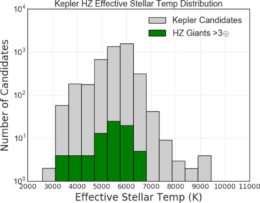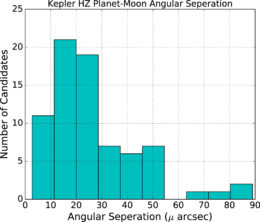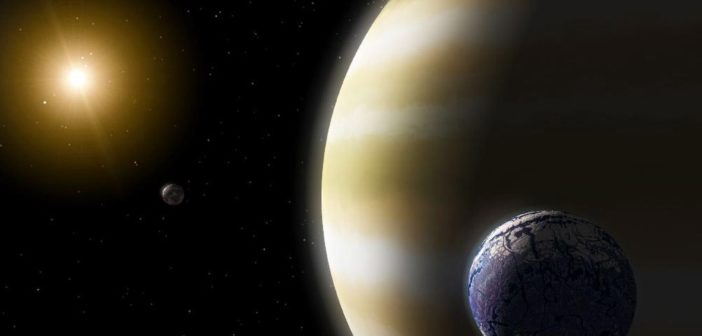One of the primary goals of exoplanet-hunting missions like Kepler is to discover Earth-like planets in their hosts’ habitable zones. But could there be other relevant worlds to look for? A new study has explored the possibility of habitable moons around giant planets.
Seeking Rocky Worlds
Since its launch, the Kepler mission has found hundreds of planet candidates within their hosts’ habitable zones — the regions where liquid water can exist on a planet surface. In the search for livable worlds beyond our solar system, it stands to reason that terrestrial, Earth-like planets are the best targets. But stand-alone planets aren’t the only type of rocky world out there!
Many of the Kepler planet candidates found to lie in their hosts’ habitable zones are larger than three Earth radii. These giant planets, while unlikely to be good targets themselves in the search for habitable worlds, are potential hosts to large terrestrial satellites that would also exist in the habitable zone. In a new study led by Michelle Hill (University of Southern Queensland and University of New England, Australia; San Francisco State University), a team of scientists explores the occurrence rate of such moons.

Kepler has found more than 70 gas giants in their hosts’ habitable zones. These are shown in the plot above (green), binned according to the temperature distribution of their hosts and compared to the broader sample of Kepler planet candidates (grey). [Hill et al. 2018]
A Giant-Planet Tally
Hill and collaborators combine the known Kepler detections of giant planets located within their hosts’ optimistic habitable zones with calculated detection efficiencies that measure the likelihood that there are additional, similar planets that we’re missing. From this, the authors estimate the frequency with which we expect giant planets to occur in the habitable zones of different types of stars.
The result: a frequency of 6.5 ± 1.9%, 11.5 ± 3.1%, and 6 ± 6% for giant planets lying in the habitable zones of G, K, and M stars, respectively. This is lower than the equivalent occurrence rate of habitable-zone terrestrial planets — which means that if the giant planets all host an average of one moon, habitable-zone rocky moons are less likely to exist than habitable-zone rocky planets. However, if each giant planet hosts more than one moon, the occurrence rates of moons in the habitable zone could quickly become larger than the rates of habitable-zone planets.
Lessons from Our Solar System

Distribution of the estimated planet–moon angular separation for known Kepler habitable-zone giant planets. Future missions would need to be able to resolve a separation between 1 and 90 microarcsec to detect potential moons. [Hill et al. 2018]
Could habitable-zone moons reasonably support life? Jupiter’s moon Io provides a good example of how radiative and tidal heating by the giant planet can warm a moon above the temperature of its surroundings. And Jupiter’s satellite Ganymede demonstrates that large moons can even have their own magnetic fields, potentially shielding the moons’ atmospheres from their host planets.
Overall, it seems that the terrestrial satellites of habitable-zone gas giants are a valuable target to consider in the ongoing search for habitable worlds. Hill and collaborators’ work goes on to discuss observational strategies for detecting such objects, providing hope that future observations will bring us closer to detecting habitable moons beyond our solar system.
Citation
“Exploring Kepler Giant Planets in the Habitable Zone,” Michelle L. Hill et al 2018 ApJ 860 67. doi:10.3847/1538-4357/aac384

6 Comments
Pingback: Exomoon, or No Exomoon?
Pingback: Exomoon or No Exomoon? – Sky & Telescope – Dinezh.com
Pingback: Exomoon or No Exomoon? – Hamilton County Weather
Pingback: Exomoon or No Exomoon? - Sky & Telescope - Worldika - New Platform For Explore World
Pingback: Exomoon or No Exomoon? – Sky & Telescope – AstroBrief
Pingback: Exomoon or No Exomoon? – Sky & Telescope | SPACE FORCE